
Movies have always been a reflection of changing tastes, technologies, and societal norms. As cinema continues to evolve, it’s fascinating to look at how certain elements, like intermissions and storytelling styles, have shifted over time. In this article, we’ll delve into the evolution of movie intermissions, the impact of modern viewing habits on cinema, and why some of us still long for the classic movie-going experience.
The Evolution of Movie Intermissions
What Were Movie Intermissions?
Movie intermissions, often seen in classic films, were breaks during long movies where viewers could stretch, grab snacks, or chat. They were a staple in the cinema experience from the early days of film until around the mid-20th century.
Why Did Intermissions Fall Out of Favor?
Intermissions began to decline as films became shorter and the demand for a continuous viewing experience grew. Advances in film technology also meant that longer movies could be shown without the need for breaks. As streaming services and modern cinema practices evolved, the concept of intermissions became less common.
The Impact of Short Attention Spans on Modern Cinema
How Have Short Attention Spans Affected Movie Making?
In today’s fast-paced world, shorter attention spans are influencing how movies are made. Filmmakers are adapting to keep audiences engaged with:
- Quicker Pacing: Films often feature faster cuts and more dynamic scenes to maintain interest.
- Immediate Hook: Opening scenes are designed to grab attention right away.
- Brevity: Many movies are now under two hours to fit the typical viewer’s attention span.
This shift is changing how stories are told and how audiences experience films.
Nostalgia in Cinema: Why We Miss Old-School Movie Experiences
What Makes Classic Movie Experiences Special?
For many, there’s a certain charm to classic cinema experiences, such as:
- Intermissions: These allowed for a pause and a chance to socialize.
- Grand Theaters: The ambiance of old movie palaces with their ornate decor.
- Film Quality: The distinct style and quality of older films create a nostalgic feeling.
These elements contributed to a unique movie-going experience that many miss today.
Why Movies Don’t Need Deep Stories to Be Enjoyable
Can Simple Stories Still Be Great?
Not every film needs a complex plot to be enjoyable. Sometimes, the appeal lies in:
- Visuals: Stunning cinematography and special effects can captivate audiences.
- Character Development: Simple yet relatable characters can be very engaging.
- Entertainment Value: Movies that focus on fun and excitement rather than deep storytelling often provide a great experience.
These films prove that enjoyment doesn’t always require a deep or intricate plot.
The Cultural Impact of The Fast and the Furious Franchise
How Has The Fast and the Furious Influenced Culture?
The Fast and the Furious series has had a significant impact on both cinema and culture:
- Global Appeal: Its success worldwide shows the power of action and spectacle.
- Car Culture: The franchise has popularized car enthusiasts and custom car culture.
- Franchise Longevity: It’s one of the longest-running and highest-grossing film franchises.
Its influence extends beyond the screen, affecting everything from car designs to pop culture trends.
The Decline of Traditional Cinema with the Rise of Streaming Services
How Are Streaming Services Changing Cinema?
Streaming services like Netflix and Disney+ have transformed how we watch movies:
- On-Demand Viewing: Access to movies anytime and anywhere has changed viewing habits.
- Original Content: Streaming platforms are producing their own films and series, changing the industry landscape.
- Convenience: The ability to watch movies from home has reduced the need for traditional cinema outings.
These changes have led to a decline in traditional cinema attendance, reshaping the industry.
Why Some Movies Are Better with an Intermission
When Does an Intermission Enhance the Movie Experience?
Certain movies benefit from an intermission due to their length and complexity:
- Long Epics: Movies over three hours long, like “Lawrence of Arabia,” can be tiring without a break.
- Complex Plots: Films with intricate stories might benefit from a pause to process information.
- Audience Comfort: An intermission allows viewers to relax and enjoy the film without feeling rushed.
These movies often provide a more comfortable viewing experience with a well-timed break.
The Debate Over Rose’s Choices in Titanic
What’s the Controversy Surrounding Rose’s Choices?
In James Cameron’s “Titanic,” there’s been much debate about whether Rose could have saved Jack by sharing the floating door:
- Physics Debate: Some argue that both couldn’t fit on the door due to weight distribution.
- Character Choices: Others believe it was a dramatic choice to enhance the film’s emotional impact.
This debate highlights how deeply audiences connect with films and their characters, leading to ongoing discussions long after the credits roll.
How MythBusters Debunked Titanic’s Floating Door Controversy
What Did MythBusters Discover?
The MythBusters team explored the floating door controversy and found that:
- Feasibility: With modifications, both characters could have fit on the door.
- Temperature: Cold water would have made survival even more challenging.
Their findings added a scientific perspective to the debate, showing how movies can spark curiosity and analysis.
The Importance of Tragic Endings in Cinema
Why Do Tragic Endings Matter?
Tragic endings often play a crucial role in films for several reasons:
- Emotional Impact: They can create a powerful, lasting emotional response.
- Character Development: Tragedy often reveals deep aspects of characters and their struggles.
- Thematic Depth: They provide a way to explore serious themes and messages.
Tragic endings can make films more memorable and impactful, resonating with audiences long after the film ends.
Movies are constantly evolving, reflecting changes in technology, audience preferences, and cultural trends. From the nostalgic charm of classic intermissions to the impact of streaming services and the enduring debate over cinematic choices, these elements shape our movie experiences in various ways. Whether you miss the old-school cinema or embrace the new trends, understanding these shifts helps us appreciate the rich history and future of film.



